Insect & Disease Conditions Update
This is the last scheduled Conditions Report of the growing season. Updates may be passed along throughout the fall and winter via GovDelivery to electronic newsletter subscribers. These updates will be archived on our Conditions Reports Index Page: http://www.maine.gov/dacf/mfs/publications/condition_reports.html. Especially significant events will be reported to all subscribers.
Thank you for your continued interest in and contributions to these reports. We value your participation as you are a critical part of the forest health monitoring network. We wish you a safe and comfortable fall and winter.
In this issue:
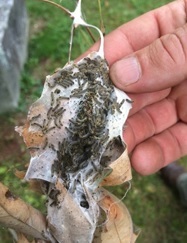
Browntail Moth (Euproctis chrysorrhoea) – As young browntail moth caterpillars start to skeletonize the leaves of their host trees in late summer, the leaves turn a distinctive coppery brown color. In late-September we conducted an aerial survey of parts of Maine that were heavily hit by browntail this past spring to look for this damage. In contrast with the amount of defoliation seen in spring aerial survey, we were able to detect a reduced area of impact in September. This is not an exhaustive survey, but does point to lower populations across much of the area impacted by browntail moth.
The leaves will soon be falling, so as you do yardwork make sure you take precautions against getting the rash caused by browntail moth. When working in heavily infested areas, wear proper protective equipment to reduce exposure, including:
- Long sleeves
- Long pants
- Goggles
- Dust mask/respirator
- Hat
- Disposable coveralls
In addition, don't use leaf blowers or lawnmowers on dry days and if possible do yardwork on wet days, which decreases the likelihood that the hairs will become airborne. Using pre-contact poison ivy wipes can help minimize hairs sticking into exposed skin. Lastly, take precautions when working in areas that are sheltered from rain like under decks and especially around firewood that has been stored under infested trees.
Details regarding any upcoming browntail moth information sessions involving Maine Forest Service staff will be shared on the Maine Bug Watch Facebook page, https://www.facebook.com/Maine-Bug-Watch-286814954695063/ and the Department Calendar, www.maine.gov/dacf. Image: Young BTM caterpillars in their winter web. Photo: Kyle Rosenberg, City of Bath.
|
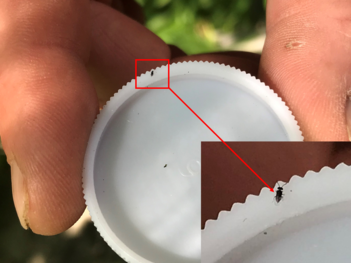
Emerald Ash Borer (EAB) (Agrilus planipennis) – No EAB were found during the mid-season check of the purple traps baited for EAB. We are currently removing traps for the year and inspecting them for a final time. Again, no additional EAB have yet been discovered. The oldest EAB larval galleries found to-date in Maine were uncovered by a technician who was branch sampling in Lebanon this month. The age of the galleries showed that EAB has been in that area near the New Hampshire border for at least three years.
Every week since late June, three species of parasitoids for EAB have been released in Madawaska, Aroostook County. Parasitoids are produced by USDA APHIS rearing labs and provided to state, federal and tribal cooperators. Two attack EAB larvae, and one attacks EAB eggs. The last release of this year was in early September. Between 3,000 and 18,000 of each species were released at various locations in Madawaska.
The Maine Forest Service (MFS) is looking for additional potential release sites for 2020 in areas with EAB (currently known in several towns in York and Aroostook Counties, www.maine.gov/eab). Ideal release sites are in or near an area where EAB has already been found and with forested areas of one acre or more having about 20 percent or more ash. Potential cooperators, such as land trusts and woodlot owners, that meet these criteria and are interested in hosting release and recovery efforts should contact Colleen Teerling at the Maine Forest Service (colleen.teerling@maine.gov or (207)287-2431.
These parasitoids will not survive in the absence of EAB, so beetle presence must be confirmed before any release is planned, and MFS will need permission for future sampling to confirm establishment of the parasitoids. Image: Oobius agrili, an egg parasite of EAB.
|
Hemlock Woolly Adelgid (Adelges tsugae) – Hemlock decline due to hemlock woolly adelgid (HWA) continues to be seen, especially along the southern and mid-coastal areas. Although some trees continue to appear relatively healthy, others are in moderate to severe decline and there are areas of tree mortality. Decline seems to have been hastened by dry weather in previous growing seasons. If you plan to do any work in hemlock trees or forests, autumn and winter are the best times to carry out operations because of minimal risk of spreading the adelgid.
Winter moth (Operophtera brumata) – As part of ongoing winter moth control efforts here in Maine, pupae of the parasitoid fly Cyzenis albicans will be released in the Boothbay Harbor area this fall. Each summer, thousands of winter moth caterpillars are collected by Maine Forest Service staff and sent to Dr. Joseph Elkinton’s lab at the University of Massachusetts at Amherst. Parasitoid larvae from infected winter moth caterpillars are then reared to the pupal stage and returned to Maine for use in our biological control program. Pupae are placed in protective cages at release sites and then allowed to emerge naturally the following spring when winter moth caterpillars become active.
Winter moth adults will emerge from the ground in late-fall and early-winter. Peak activity is expected in near-coastal areas from Kittery through Mount Desert Island, and during the weeks between Thanksgiving and Christmas. Traps to monitor populations will be deployed in early December.
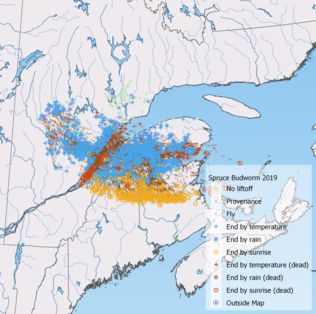
Spruce Budworm (Choristoneura fumiferana) – There was a flurry of spruce budworm (SBW) flight activity to the north this season and our friends in Quebec and New Brunswick have been busy monitoring SBW dispersal flights with radar, using atmospheric data to model dispersal flights, performing aerial spraying in outbreak areas, and trying a novel approach of early intervention spraying in areas where SBW populations are building. We in Maine are very appreciative of the tremendous efforts of our Canadian counterparts and their willingness to share with us the valuable information they learn along the way.
The fact that SBW dispersal flights can be detected on radar should give you an idea of the scale of the Canadian outbreak and just how numerous these moths can be. Because SBW dispersal is largely dependent upon atmospheric conditions, we are fortunate today in that unlike the last major SBW outbreak of the 1970s, highly-detailed weather data can now be used to build intricate flight models. These models help us to predict where migrating moths may have shown up in Maine this year and where we might expect to see future damage (See Figure). By monitoring the daily trap catches and models provided by Canadian researchers, we were able to time the collection of Maine SBW traps to capture the entire flight season. Traps were picked up a bit later this year, which means that there is very little data to report as this article is being written.
Though wind patterns this season were mostly favorable from a Maine standpoint and carried most moths well away from our northern forests, there is still evidence of a few significant in-flights into Aroostook Co. (See Figure). Even though the moths may have arrived in great numbers, it still does not necessarily ensure reproductive success, as adult moths are often torn, tattered, and totally spent after long dispersal flights.
Cooperative Forestry Research Unit (CFRU)-led overwintering larval (L2) sampling will help to understand the local impacts of those moth flights. Branch samples are being collected by CFRU cooperators in Maine, defoliation assessments will be conducted by students at University of Maine Fort Kent and Orono, and then branches will be sent on for processing in New Brunswick. Given all the 2019 adult SBW activity, the Canadian Forest Service Lab in New Brunswick has agreed to expedite processing of a portion of Maine’s samples. That will allow land managers to perform secondary targeted larval sampling as desired in the event of any higher larval numbers. So far, early supplemental L2 sampling in New Brunswick around high trap captures has not revealed corresponding high levels of L2 populations. Image caption: Example of an SBW flight simulation model from July 20th, 2019 showing a large in-flight of adult moths into northern Aroostook Co. Image generated from BioSIM output, courtesy of R. Saint-Amant, Canadian Forest Service.
|
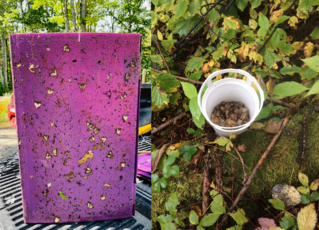
Gypsy Moth (Lymantria dispar) – Although we use traps especially designed to attract gypsy moths, it seems that large numbers of male gypsy moths have been finding their way into traps designed for other insects as well this season. Male gypsy moths have been filling the collection buckets in our SBW pheromone traps in certain areas and have been covering our sticky purple prism traps designed for emerald ash borer in others. This curiosity might be some indication of the abundance of gypsy moth this year, but more likely the amount of gypsy moth lure stored in the same freezer as other lures used in trapping.
Fortunately, most areas where we know we have higher gypsy moth populations are still relatively damage free. However, if you live in Maine and notice an abundance of new gypsy moth egg masses in your area that weren’t there in past years, please contact Mike Parisio at michael.parisio@maine.gov or (207) 287-7094. Image caption: Male gypsy moths plastered to a purple prism trap hung in the Harpswell area (left) and male gypsy moths filling the collection bucket of an SBW trap hung in Baxter State Park.
|

Introduced Pine Sawfly (Diprion similis) – Several reports have come in since our last conditions report alerting us to high localized populations of introduced pine sawfly in the greater Bangor/Orono/Old Town area and on Mount Desert Island. Additionally, UMaine extension has received calls from the towns of Dedham, Lewiston, Biddeford, Ellsworth, Unity, Wayne, and Waldoboro, and several introduced pine sawfly larvae were collected at the annual Bug Maine-ia event here in Augusta. Although these caterpillar-like larvae are commonly confused with true moth or butterfly caterpillars, they belong to a group of primitive wasps know as sawflies. As the name implies, introduced pine sawfly targets mainly white pine, but there are many different species of sawflies that target specific host plants. Introduced pine sawfly has up to two generations per year, with the second generation that people are seeing now active well into September. By now, the mature larvae should be spinning cocoons to overwinter, which can often be found attached to the twigs of pines. Like many other species of sawflies, some of these cocoons will also spend the winter concealed safely in the leaf litter. If deemed necessary, those that know they had significant populations on their properties this year and experienced significant defoliation damage can consider insecticide treatment with an approved pesticide (e.g. acephate, carbaryl, imidacloprid, or certain pesticidal soaps) next season while young, small larvae are still feeding together in large groups. Treatment becomes more difficult once larger larvae begin to disperse to meet greater individual food demands. Image caption: (left) Once mature, introduced pine sawfly larvae can be easily distinguished from most other sawflies by their spotted yellow, black, and white coloration. (right) A mass of introduced pine sawfly cocoons on a white pine branch whorl in an outbreak area. At normal population levels, these are often found as individual cocoons.
|
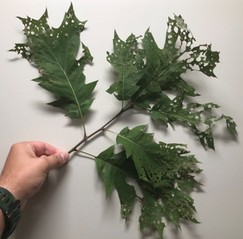
Oak Shothole Leaf Miner (Agromyza viridula) – In case you missed our June conditions report, we wanted to send out a friendly reminder about oak shothole leaf miner. After having a chance to catch up with colleagues in other states during the field season, it seems that this occasional pest was widespread not only in Maine this year, but also throughout most of New England and parts of the mid-Atlantic. If you participate in the time-honored tradition of leaf raking and happen to have a lot of oaks in your yard, there’s a very good chance you’re going to notice oak leaves riddled with small holes. This minor but apparent damage occurred months earlier and was present throughout the entire growing season, only to end up on your lawn in plain sight now that the leaves are starting to drop. Now that you know the cause, no need to fret. Image caption: Do not be surprised if you encounter oak shothole leaf miner damage that looks like this while raking leaves this fall.
|
Red Pine Scale (Matsucoccus matsumurae) – Red pine scale was detected in Kittery, York County Maine, earlier this month. This invasive insect is thought to be one of the important factors leading to the widespread decline of red pine in the Northeast. Detailed investigation of red pine decline has been conducted by US Forest Service collaborators at the University of New Hampshire, however a final report on the work is pending. Other factors in the decline include fungal blights, Sirococcus conigenus and Diplodia sapinea which were covered in our Annual Summary Report for 2018 (page 17). Regardless of the factors leading to decline, there are noticeable pockets of diseased and dead red pine throughout the state and region.
Red pine scale arrived in North American in the first half of the last century. It has thought to have been introduced on trees brought from overseas to the World’s Fair in Flushing Meadows, New York in 1939. It has only recently come to attention in Northern New England, thanks to detections by our colleagues in New Hampshire Division of Forests and Lands. The first detection in Maine was in Mount Desert (Hancock County), Maine in 2014 with subsequent detections throughout Mount Desert Island and in Lamoine (Hancock County, 2017).
 This insect is likely impacting trees in other areas. It is highly cryptic until associated with rapid decline and mortality of the host, at which point all the needles on branches or whole trees turn brick red. Early work indicated this insect was not particularly tolerant of winter cold, however contemporary evidence from detections in other northern New England States suggests this is not the case. Based on this evidence and plant hardiness zones, we expect this insect could survive as far north as Millinocket here in Maine.
Unfortunately, once red pine scale causes symptoms severe enough to be detectable, treatment is generally no longer feasible. Little work has been done on control of the scale on ornamental trees, and early investigations into biological controls were fruitless. However, on ornamentals showing only minimal damage, some control can be attained by two applications of horticultural oil at two percent rate (applications in early June and early September). Fertilization in this situation can be detrimental and should be avoided. We encourage those with plantations of red pine to monitor them closely and frequently due to this insect and the previously mentioned fungal diseases. Conducting red pine stand inspections and harvests of infested stands in winter months will help reduce the risk of moving this pest. Image caption: Left: Discolored foliage of red pine in late-stages of decline associated with red pine scale infestation (Photo courtesy of Billy Helprin); Right: Evidence of red pine scale infestation such as the settled nymphs (arrow top) and flocculence (arrow bottom) is often hidden beneath loose bark scales on twigs and branches.
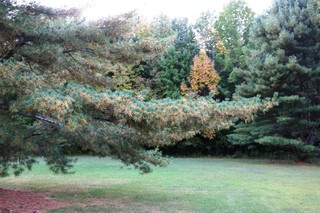
Natural Fall Needle Shedding - This time of year, you may notice on most conifer species* that the leaves/needles on twigs and branches furthest from the branch tips/buds (the oldest needle age classes) are turning pale yellow to orange and may be shedding onto the ground. Unless clear signs of injury or wilting are visible, there is no cause for alarm. This is very likely simply due to the natural phenomenon of seasonal needle drop and not an insect or disease problem. In white pine, this is different from the early summer defoliation due to white pine needle damage that is caused by a complex of fungal pathogens: white pine needle damage has been common over the past several years.
Conifers shed older needles in the fall because they are less productive in collecting resources for growth and defense. The resources that the tree saves on maintenance of older needles can be invested in newer growth, which has higher photosynthetic output.
Seasonal needle drop can be expected to be more noticeable in some parts of Maine than others this year. This can be due to the specific conditions in different parts of the state during the growing season, as stress tends to increase seasonal shedding of conifer foliage. In areas heavily impacted by white pine needle damage, this seasonal needle drop will not be seen, since the older needles have already been shed due to fungal infection.
*Deciduous conifers like larch species and dawn redwood will lose all of their needles (leaves) in fall and re-foliate each spring. Image: Open-grown white pine showing orange, older needle age classes that will be shed this autumn.
|
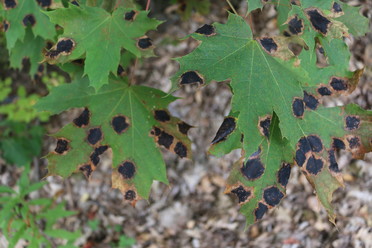
Tar spot of maple (Rhytisma acerinum) – Tar spot of maple caused by the native fungus, R. acerinum, is especially prevalent in several parts of Maine this year. R. acerinum affects the non-native Norway maples, including several cultivars common in horticultural settings, such as the burgundy-leaved Crimson King maple. There are three other species of fungi in the genus Rhytisma that produce a tar spot symptom on our native maples, but these are encountered less frequently and typically cause minor damage.
The fungi that cause tar spot survive the winter in fallen leaves and produce and disseminate spores during prolonged periods of wet weather in spring. Although infections happen in spring, the tar spot symptom does not appear until late in the season and is easily observed now. This year, May and June were particularly wet in many parts of Maine, which typically leads to high disease incidence and severity in late summer. Collecting and disposing leaves in fall is the most practical recommended management strategy. If composting the collected leaves on-site, the leaf piles should be covered with a layer of soil, a dense layer of grass clippings or other compost. This will prevent the fungus from dispersing spores to re-infect maples the following spring. Leaves can also be burned when and where this is permitted. While fungicides are available and effective, chemical management of tar spot is rarely required and is often not practical.
In a forest environment, tar spot diseases rarely are severe. Heavily affected leaves are prematurely shed by the tree, which can prevent complete development of spore-producing structures. Also, leaves dropped early are largely covered up by layers of leaves of other forest trees during normal fall leaf drop, blocking spring spore dispersal.
The tar spot diseases primarily represent an aesthetic issue to ornamentals and have little detrimental effect on the long-term health of affected trees. Infected leaves retain most of their photosynthetic capabilities throughout most of the growing season and buds for next year’s growth are already set by the time the black spots form. Leaf drop is late enough in the season so that a re-foliation by the tree is not usually triggered. This means that the energy reserves already stored will be preserved and sufficient to compensate for any damage, allowing the tree to develop normally next spring. Image: By late summer, black fungal spots develop, which are the spore-producing structures of the fungus responsible for next year’s infections. Leaves with multiple infections eventually turn brown and drop prematurely from the tree.
|
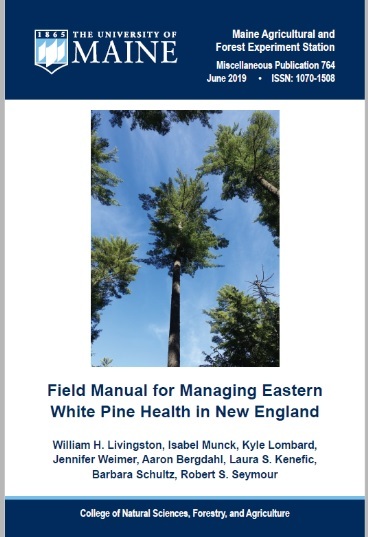
A new Manual on Managing Eastern White Pine Health is now available - A new publication titled ‘Field Manual for Managing Eastern White Pine Health in New England’ has been collaboratively produced to provide readers guidance for identifying and evaluating important health problems of eastern white pine in New England. Covered pests include white pine weevil, blister rust, bast scale, white pine needle damage, Caliciopsis canker, and red rot or red-ring rot. The manual also outlines silvicultural practices that can reduce risks of health problems and improve productivity and quality of eastern white pine at various stages of stand management.
In addition to serving as a resource for forest managers, the field manual can help woodland owners understand the risks to eastern white pine health and help justify forest management practices.
The report was authored by a group of northeastern forest health professionals including William Livingston, University of Maine School of Forest Resources; Isabel Munck, Northeastern Area State and Private Forestry of the USDA Forest Service; Kyle Lombard and Jennifer Weimer, New Hampshire Division of Forests and Lands; Aaron Bergdahl, Maine Forest Service; Laura Kenefic, Northern Research Station of the USDA Forest Service; Barbara Schultz, Vermont Department of Forests, Parks and Recreation; and Robert Seymour, University of Maine School of Forest Resources (emeritus). The manual is currently available online. To download a copy, scan the QR code below or visit the Maine Agricultural and Forest Experiment station’s miscellaneous publication section at https://digitalcommons.library.umaine.edu/aes_miscpubs/24/.
|
Office hours are 7:30 am to 4:00 pm, Monday through Friday, except for holidays. Because this is as secured building, you should call ahead to make sure someone will be present to meet with you. (207) 287-2431.
NOTE: The Augusta office has moved to the Deering Building, 90 Blossom Lane. The mailing address and phone numbers are unchanged. A map is available on our website, https://www.maine.gov/dacf/mfs/forest_health/contact_us.html. The old lab at 50 Hospital Street is currently housing the Kennebec County Soil and Water Conservation District.
Conditions Report No. 4, 2019
On-line: https://www.maine.gov/dacf/mfs/publications/condition_reports.html
Department of Agriculture Conservation & Forestry
Maine Forest Service – Forest Health and Monitoring Contributors: Aaron Bergdahl, Allison Kanoti, Mike Parisio, Thomas Schmeelk, and Colleen Teerling
Unless otherwise noted, photos by Maine Forest Service, DACF
|